HIGHLIGHTS
Dynamics 2025 PLANNING FOR URBAN EXPANSION
Africa’s
Urbanisation








Urbanisation







Joint report by the AfDB, Cities Alliance, OECD/SWAC and UCLG Africa








Over the next three decades, Africa will experience an unprecedented increase in its urban population, doubling from 700 million to 1.4 billion people by 2050. It will become the continent with the second largest urban population after Asia (3.5 billion). Nigeria is projected to have an urban population of 250 million —the fourth largest urban population in the world —while Egypt, with 147 million, will rank among the top ten globally. Cities will absorb 80% of the total projected population growth and two out of three Africans will live in urban areas by 2050.
Africa’s urban transition poses both an urgent challenge and an unparalleled opportunity. Proactive planning, effective governance and innovative financing strategies are essential to ensure that cities thrive. By acting now, Africa can manage urban growth in ways that promote sustainability, inclusiveness and resilience, setting the stage for a prosperous urban future.

Africa’s Urbanisation Dynamics 2025: Planning for Africa’s Urban Expansion, provides the most comprehensive view to date of Africa’s future urbanisation dynamics. It explores the implications for urban planning, governance and financing, providing policy makers, development partners and experts with projections, insights and actionable recommendations for managing urban transitions.




The urban expansion projections to 2050 used in this report are from the Africapolisurbanisation database. The report provides policy makers with detailed insights into urban population growth and spatial expansion across 11 000 urban agglomerations in 54 countries. These projections reveal significant regional trends and spatial features that can inform urban planning at the national, metropolitan and agglomeration levels, shaping sustainable and liveablecities.
Eighty percent of Africa’s projected demographic growth from 2020-50 will be absorbed by urban areas. By 2050, two out of three people will live in an urban agglomeration. Urbanisationlevels are projected to increase from 54% in 2020 to 65% in 2050. This dynamic will continue to shape urban networks, resulting in more and larger cities. The number of urban agglomerations with over 10 000 inhabitants is expected to increase by over 2 000, from 9 000 in 2020 to more than 11 000 in 2050.
By then, Africa will have 159 urban agglomerations with over 1 million inhabitants and 17 megacities with more than 10 million inhabitants, the second most of any continent. More than the purely aggregate numbers, these changes highlight the massive urban transformations projected over the next 30 years.





More than two-thirds of Africa’s projected urban growth will take place in large cities. The population living in large urban agglomerations of more than 1 million inhabitants will grow from 325 million in 2020 to 836 million in 2050, and their share of the total urban population will increase from 46% to 59%. Conversely, the share of people living in small urban agglomerations (10 000 to 100 000 inhabitants), will decrease from 29% to 19% between 2020 and 2050, despite an increase from 209 million to 275 million in absolute terms. Similarly, populations in intermediary urban agglomerations (100 000 to 1 million inhabitants) will increase from 183 million in 2020 to 310 million people, but their relative share of the continent’s total population will decrease from 26% to 22%.
Africa’surbanareaswillmorethandouble
Driven by population growth, African urban agglomerations will see strong expansion of their built-up areas. New residents and growing cities will require land for diverse uses including housing, commerce, industry, public infrastructure (schools, hospitals, administrative buildings) and transport facilities (airports, logistics depots). The growth in urban area expansion is projected to outpace urban population growth, at 3.2% compared to 2.3% per year. The total urban footprint is projected to increase from 175 000 square kilometresto 450 000 square kilometresbetween 2020 and 2050. This expansion will significantly impact urbanisationdynamics, serving as a crucial metric for understanding growth patterns, infrastructure needs and environmental pressures.





The key challenge facing Africa’s urban agglomerations is how to make room for their growing populations. Projected urban growth will pose major challenges for urban planning as it is outpacing the capacity of many central and local governments to provide housing, basic services and infrastructure. At the same time, the need to build large parts of Africa’s future cities also presents an opportunity to plan cities that are better designed for the 21st century and better equipped to deal with major challenges such as climate change, housing and transport. Past failures and current thinking in other regions of the world offer lessons that urban planners and governments can learn from. However, there is also a need for African urban planners to develop and experiment with new ideas, and to integrate local realities and contexts into the design of the continent’s urban future.
Theneedtoplannow

As most urban areas will be built in the next few decades, policy makers must strengthen the relevance, capacity and speed of urban planning. The way cities are built has an impact on every aspect of urban life, including access to jobs and services, health, social interactions, safety, the cost of living and doing business. Urban planning can limit or reinforce existing inequalities, such as women’s labourmarket participation, and it shapes the interactions of urban areas with their surrounding ecosystems and hinterlands.




African cities can innovate and explore new urban planning solutions. New technologies and data can enhance urban planning processes. Integrating climate, environmental and energy considerations into urban growth planning could lead to lasting reductions in greenhouse gas emissions, reduced exposure to extreme weather, and more sustainable, resilient cities. African approaches to urban planning should prioritisestakeholder participation and local capacity to manage growth efficiently and inclusively. All this points to the urgent need to reinforce planning capacities at local and regional levels.





Governance is crucial for managing the urban transition. Many African countries require renewed urban governance frameworks, including stronger local governance structures, improved multi-level co-ordination, and more inclusive policies. National urban policies and national development policies will be instrumental in addressing the urgency of urbanisation.
Effective urban governance action needs to be at the right scale and reach all inhabitants and economic activities. Centralised, siloed policy making should shift to an integrated, inclusive approach for managing cities and towns. This requires co-operation and co-ordination across levels of government, devolving responsibilities and resources. New urban governance must be responsive to local conditions and deliver necessary infrastructure and services.
Stakeholder engagement is essential for representation and accountability.

Effective management of projected urban expansion requires robust local government institutions within a strong, supportive national framework. Familiar with local dynamics, local governments are well-positioned to influence urban policies and manage essential services. To ensure their effectiveness, national constitutions must recognisesubnational governments as autonomous, granting them legal and financial authority, and clearly defining their roles within the broader governance system.




Effective urban governance relies on a functional land management system. In many African countries, the formal land governance system is unable to identify, consolidate, plan, service and deliver land for public, residential and commercial use at the scale required to manage urban growth effectively. This has profound implications for the ability of local governments to meet their land-use planning objectives.
Jurisdictional fragmentation complicates setting policy objectives, urban governance and power distribution between governance bodies. This issue is exacerbated by the expansion of urban agglomerations, particularly large metropoles. Governments need to adapt existing scales of governance and establish institutions at appropriate geographical levels.

Most urban residents in Africa live in informal areas, and much of the economic activity that takes place in the urban environment is informal. The continued failure to recognisethese populations and activities drastically reduces the scope for governments to act. In order to respond to conditions on the ground and deliver the necessary services and infrastructure for all, urban governance needs to consider and involve all urban residents.




Rapid urbanisationcreates high demand for investment in infrastructure and public services. However, current levels of spending in African cities are very low and fail to meet the needs of their rapidly growing populations. Existing systems for financing urban development face both quantitative and qualitative problems. Structural barriers, such as regulatory constraints and limited fiscal capacity, prevent more resources from reaching cities. Closing the financing gap also requires making more effective use of available investment funds.
Governmentstrategy,planningandregulation areneededtoincreaseinvestment

Financing urban expansion requires a long-term strategic approach to urban development that sets objectives and priorities. Governments play a central role in steering spending priorities through policy and direct investment. A unified government strategy that includes vision, governance reform and regulation, is essential for boosting investment in urbanisation. The benefits of urban investment will yield results in the long term. However, inaction risks locking in long-term costs. In particular, climate-resilient solutions should be built into the design of infrastructure and service delivery from the outset, positioning these investments as benefits for the future rather than burdens.




To meet the challenges and seize the opportunities brought by urban growth, governments must significantly increase urban investments. Central governments need to create the conditions to scale up available funding to cities. This requires measures to increase the fiscal space of public institutions, improve access to credit and deliver regulatory frameworks that work for African cities. Countries should also adopt consistent spatial planning approaches based on real financing conditions, prioritisingspending that supports urban growth and promotes sustainable and inclusive development. Strategies to leverage alternative sources of finance and attract additional private investment are also essential.
Theneedtospendbetter
A priority for African cities is to align investment spending with the needs and realities of residents and businesses, while increasing private sector and civil society involvement.
Achieving this requires focusing urban investment on real and agreed objectives, rooted in each country’s contexts, economic aspirations, and social and environmental goals. Currently, a misalignment exists between financed projects and actual needs, as well as between project costs and available funding. Smaller, cheaper and therefore more rapidly realisedprojects can deliver infrastructure and services at the pace and scale required by rapidly growing cities. Smaller local projects also have the advantage of involving more local economic actors, whether formal or informal.

Moreover, investment spending should be more evenly distributed across urban agglomerations, including intermediary and small ones. Considering urban clusters, corridors and connectivity in investment planning will help distribute the benefits of the agglomeration economy more widely across national territories.






Africa’s urban population is projected to double between 2020 and 2050, adding 700 million new urban residents to reach 1.4 billion people. This unprecedented urban expansion presents urgent challenges, but also unparalleled opportunities. Proactive planning, effective governance and innovative financing strategies are essential to ensure that cities can thrive and deliver on their potential to drive inclusive economic development. By acting now, Africa can manage its urban growth in ways that promote sustainability, inclusiveness and resilience.






This report provides projections of future urbanisation dynamics in Africa and explores the implications for urban planning, governance, and financing based on:
• Demographic and spatial projections for over 11 000 urban agglomerations in the 54 countries in Africa
• Africapolis–visualise urbanisation in Africa database –providing historical demographic and spatial growth data
• The inclusion of key features of urban expansion, such as rural transformations, in-situ urbanisation, merging and absorption
Projecting and mapping urban expansions are essential metrics for understanding patterns of urban growth, infrastructure needs, and environmental pressures.

• Africa’s population is projected to reach 2.2 billion by 2050, 80% of this growth will be urban.
• By 2050, the continent’s urban population will have grown by 704 million to reach 1.4 billion.
• Africa will be the continent with the second-largest urban population behind Asia.
• Nigeria and Egypt will have the largest urban population by 2050 in the continent and will be in the top ten largest urban populations in the world.
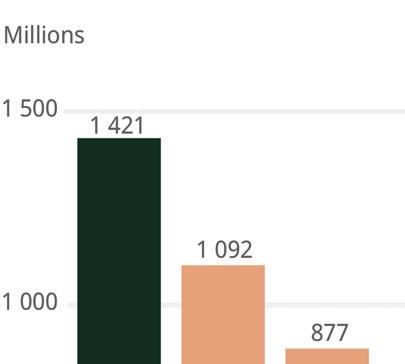





The share of people living in cities will increase from 54% in 2020 to 65% in 2050. Only 12 countries, the majority in West Africa, will have a level of urbanisationbelow 50% in 2050.
Level of urbanisation in Africa, 2020-50

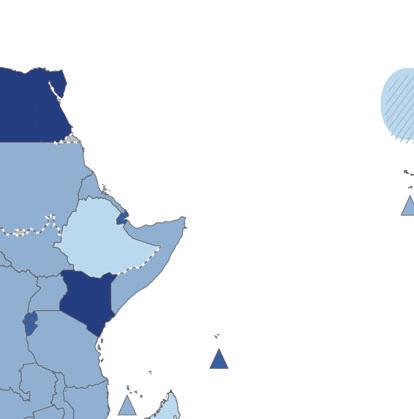
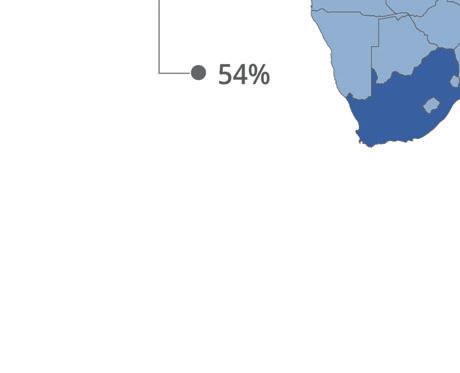




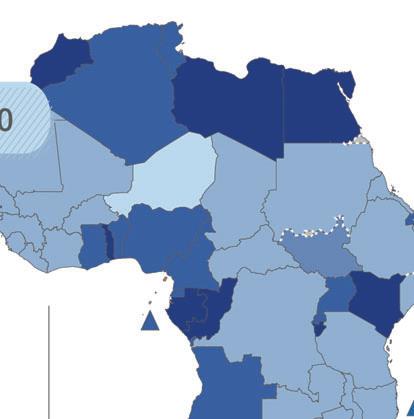



The number of urban agglomerations in Africa will increase from 9 000 in 2020 to over 11 000 in 2050.
Nigeria, Egypt, Ethiopia and DRC will account for 36% of all 11 139 cities on the continent.
New urban agglomerations, 2050
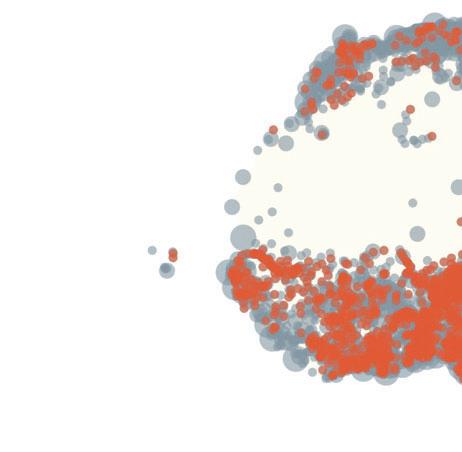


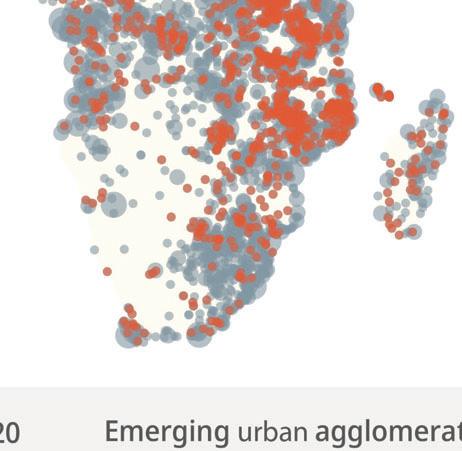



In 2050, Africa will have 159 urban agglomerations with more than 1million inhabitants and 17 megacities with more than 10 million inhabitants, the second most of any continent.

The 10 largest agglomerations in 2050


The number of people living in urban agglomerations with more than 1 million inhabitants will grow from 325 million in 2020 to 836 million in 2050 and their share in the total urban population increase from 46% to 59%.
Urban agglomerations with more than 1 million inhabitants, 2050
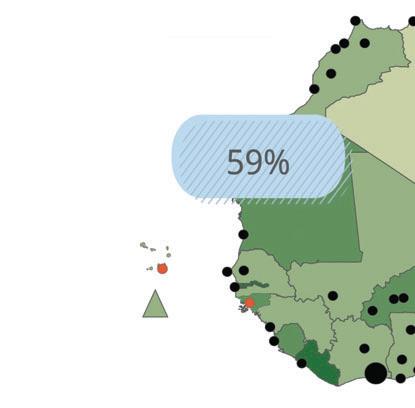


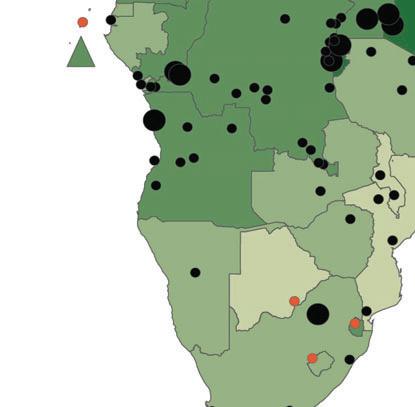



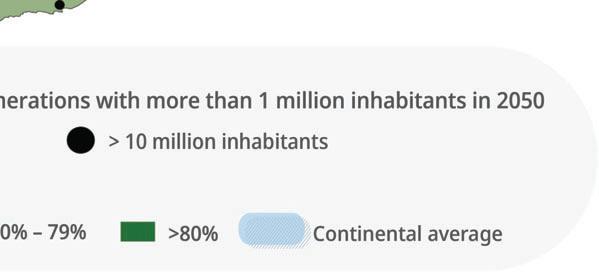
Urban population growth, 2020-50
The population growth of large and intermediary urban agglomerations between 2020 and 2050 is projected at 2.8% and 2.7% respectively (average annual compound rate). Small urban agglomerations are projected to grow at an average annual rate of 2.2% over the same period.
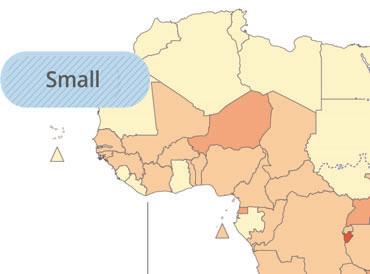


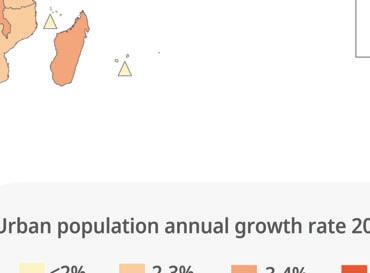



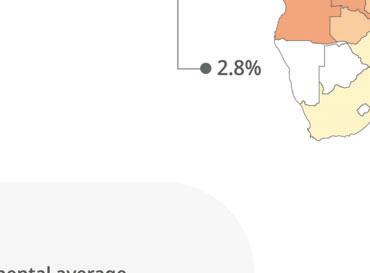


African coastal and interior urban agglomerations, 2050
By 2050, 98 out of the 100 fastest growing urban agglomerations will be in the interior, and 6 out of 8 the continent’s projected megacities with more than 20 million inhabitants. This often overlooked dynamic requires a new understanding at the role of cities in the continent’s integration.


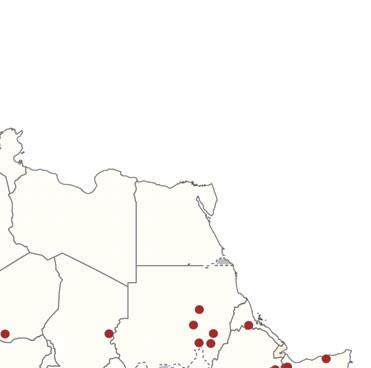
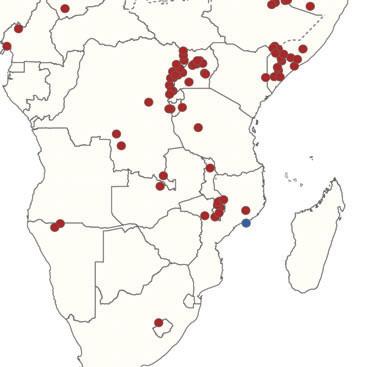
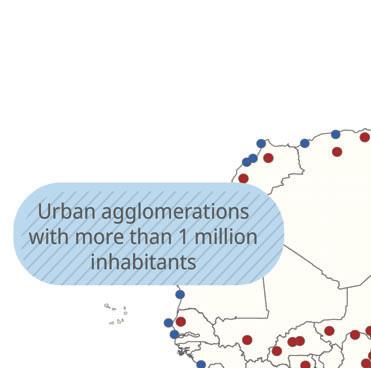



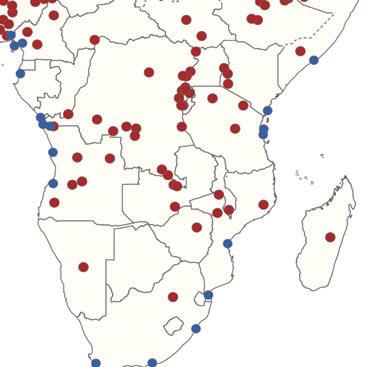

• New urban dwellers and growing cities will require land for all sorts of uses, from housing, commercial constructions for retail, businesses and industry; public building (schools, hospitals, administrative buildings, etc.); to transport infrastructure and facilities (airports, logistics depots, etc.).
• The total urban footprint is projected to increase from approximately 175000 km2 to 450000 km2 between 2020 and 2050. Despite this expansion, cities will account for less than 2% of the total continental land area in 2050.
Annual growth of urban built-up areas in Africa, 2020-50



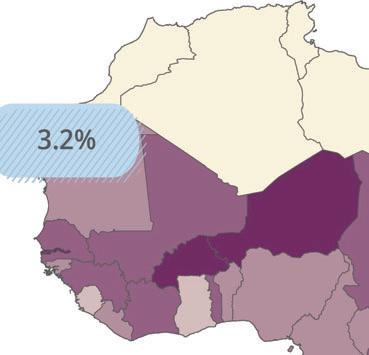




The growth in urban area expansion is projected to exceed the growth in urban population, 3.2% compared to 2.3% per year. Urban population growth does not translate directly into urban area growth due to a variety of political, environmental, and historical factors. Politically, zoning laws and urban planning policies can restrict the physical expansion of cities. Environmental constraints, such as the availability of water, arable land, and the presence of natural barriers like mountains or bodies of water, can limit the sprawl of urban areas. These intertwined factors create a complex dynamic and highlight the diversity of national contexts in Africa.
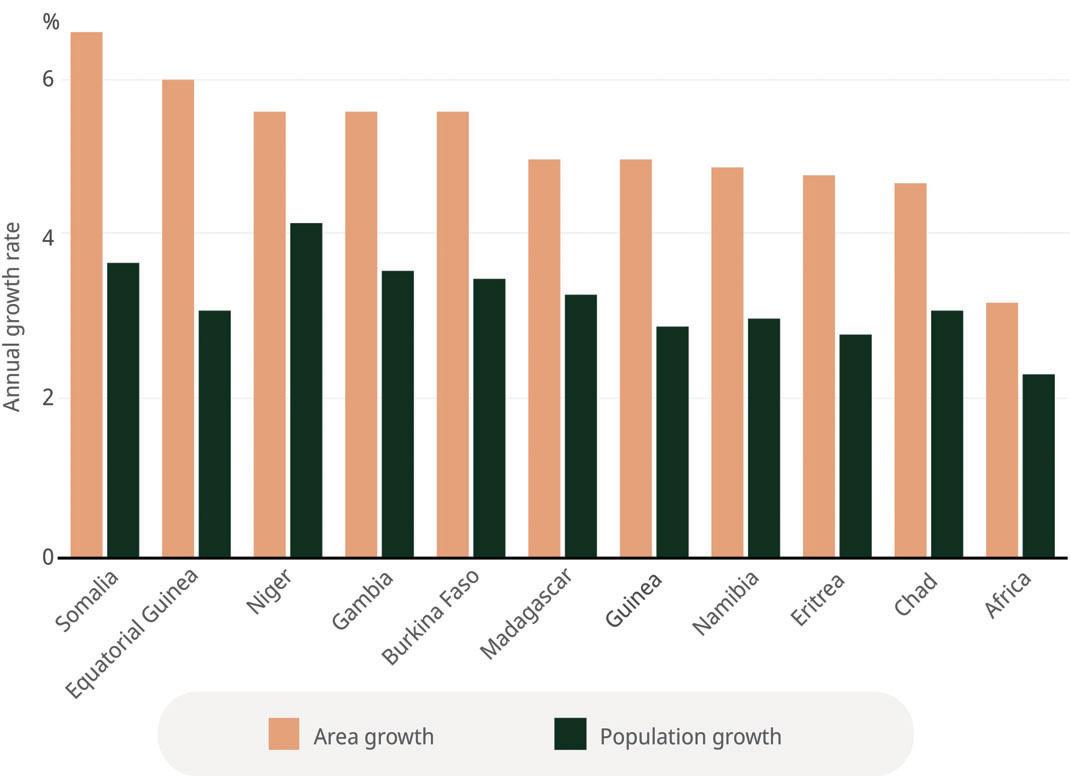
The built-up areas of the average large and intermediary urban agglomeration are projected to grow at an annual average of 4.1% compared to 3.1% for small urban agglomerations between 2020 and 2050. Agglomerations with 1 to 2 million inhabitants are projected to have the fastest area growth at 5.2% annually.
Average urban area growth by agglomeration size, 2020-50
Driven by urban expansion, many cities will absorb existing urban and rural agglomerations along its expansion trajectory, leading to the creation of larger agglomerations. At agglomeration level, the contribution of fusion and absorption to population and area growth can vary greatly. Despite being observed across all city size, it contributes particular to the growth of large cities.
Contribution of fusionand absorption to population and spatial growth of urban agglomerations



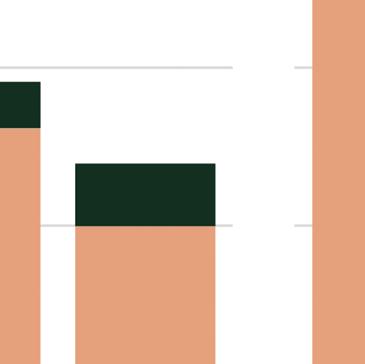





By 2050, the 10 largest urban agglomerations in Africa will on average have fusionedwith 56 urban agglomerations. For these agglomerations, fusion explains 41% of the total population growth and 40% of their spatial growth. In Kampala, Uganda, 36% of the projected population growth is explained merging and absorption of nearby urban agglomerations and rural settlements. Kampala is projected to merge with five urban agglomerations with over 100 000 inhabitants by 2050, with 40 urban agglomerations with populations between 10 000 and 100 000 inhabitants and absorb 235 rural settlements.





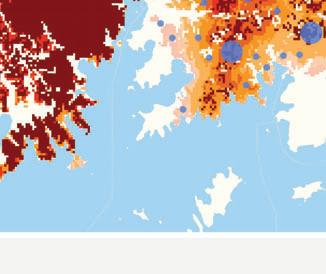
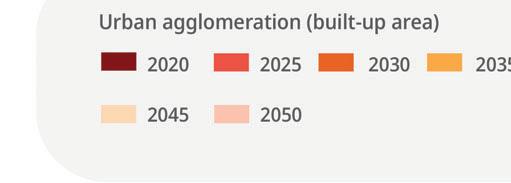
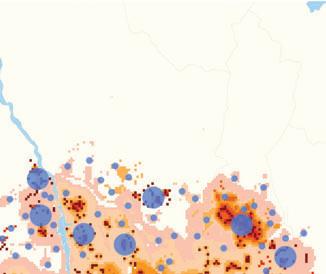





The development of mega-agglomerations is driven by the expansion of large urban agglomerations and the strong population growth in the surrounding areas leading to large scale fusion and absorption. Megaagglomerations form complex socioeconomically connected urban landscapes, although featuring lower population densities and leaving many unbuilt gaps. The formation of these large urban units is generally not captured by official statistics and definitions.
Urban expansion Nairobi, Mount Kenya, built-up area in 2050
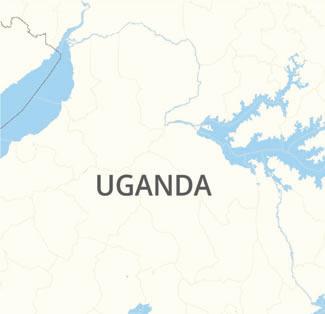





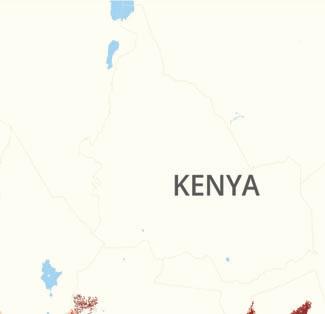

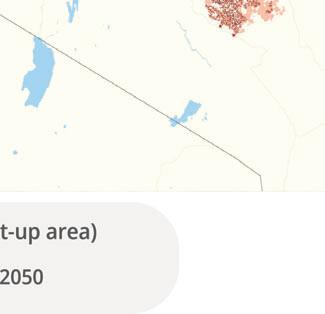






• The key challenge facing Africa’s urban agglomerations is how to make room for their growing populations.As in other regions of the world, urban population growth will inevitably lead to expansion—as the amount of land needed to accommodate growing populations increases.
• The way in which city expansion is planned and built impacts every aspect of urban life: on residents’ access to jobs and services, on their health, social life and safety. It can limit or reinforce inequalities and exclusion, such as women’s participation in the labour market. The way cities are built will also impact transformations in their hinterlands and its interactions with ecosystems.




• The capacity of urban planning to design Africa’s urban future needs to be strengthened. African urban planning needs to develop and experiment with new ideas and to integrate local realities and contexts into the design of new plans.
• Most of Africa’s urban areas will be built in the next few decades. Because of the rapid pace of urban expansion and the slowness of the urban planning process, it is crucial to begin planning for growth today.




• For urban planning to be effective, plans must be correctly dimensioned. Plans need to reflect actual needs based on realisticprojections of urban growth. They need to consider the full functional extent of the agglomeration, beyond administrative boundaries. Importantly, plansalso need to correspond to actual financial and economic capacities to ensure implementation.
• Urban planning needs to systematically integrating climate, environmental and energy considerations into the planning of urban growth to reduce exposure to extreme weather events and make cities more sustainable and resilient.




• Centralised,siloedpolicymakingmustgivewaytoanintegrated,inclusive approachtomanagingcities.Enablingeffectivemulti-levelgovernanceneeds toempowerlocalgovernmentsandotherurbanstakeholders.Thisrequires activecollaborationandco-ordinationbetweendifferentlevelsofgovernment andassignmentofappropriateresponsibilitiesandresources.
• Goodgovernancesystemssetclearobjectives,policiesandproceduresto ensurethatpublicandprivateactionresultsinconcreteimprovementsonthe ground.Tobeeffectivetheyneedtobedesignedattheappropriatescaleand reachallinhabitantsandeconomicactivities.




• Apivotalelementofurbangovernanceisthemanagementofland.Rapid urbanexpansionwillamplifypressuresonlandgovernancesystems.Land governancesystemsneedtoidentify,consolidate,plan,serviceandmake landavailableforallusesatthescalerequiredtomanageurbangrowth effectively.
• Effectivelandgovernancesystemsarecrucialforgrowingcities,asthey enableurbanplanning,provideessentialresourcesforlocalgovernments, andattractincreasedinvestmentsbyensuringsecurelandtenureand transparentregulatoryframeworks.




• MosturbanresidentsinAfricaresideininformalareas,andmuchofthe economicactivitythattakesplaceintheurbanenvironmentisinformal.The ongoingfailuretorecognisethesepopulationsandactivitiesdrastically reduceslocalgovernments’rangeofaction.
• Torespondtoconditionsonthegroundandtodelivertheneededservices andinfrastructureforall,urbangovernanceneedstoconsiderandinvolveall urbanresidents.


• Financing urban expansion requires a long-term strategic approach to urban development that determines objectives and priorities. Governments play a central role in steering spending priorities through policies and direct investments. A unified government approach incorporating strategic vision, governance reform and regulation is essential to boost investment.
• More effective regulatory frameworks are needed to increase the availability of funds for urban development, from both private investors and public actors.

• Current levels of spending in African cities are very low and fail to meet the needs of rapidly growing urban populations. National and local governments must increase investments.
• Increasing climate change adaptation and resilience investments are crucial for sustainable and livable cities.
• Beyond government spending, it is essential to leverage alternative financing sources and attract additional private investment.


• A priority is aligning investment spending with the needs and realities of residents and businesses, while increasing the involvement of the private sector and civil society. To achieve this, it is imperative to refocus urban investments on real and agreed objectives.
• Smaller, cheaper and therefore more rapidly realisedprojects rooted in the local context can provide infrastructure and services at the pace and scale required by rapidly growing cities.


















